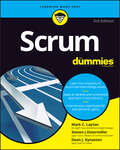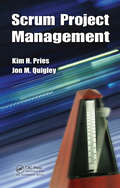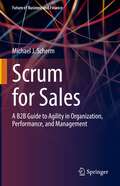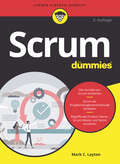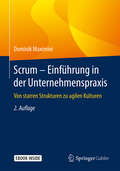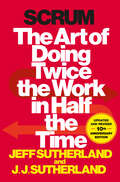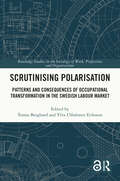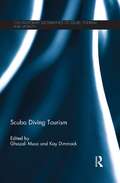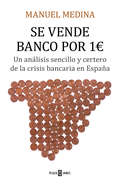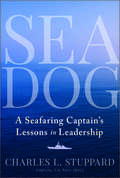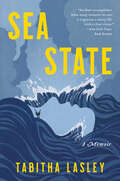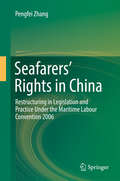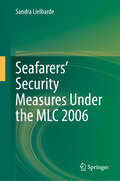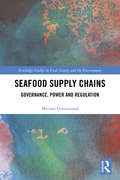- Table View
- List View
Scrum For Dummies
by Mark C. Layton Steven J. Ostermiller Dean J. KynastonLearn how scrum can help in every part of your life Scrum—an organizing approach that exposes work progress and quality —is used all over the place in software development, but it&’s not just for coders. Scrum For Dummies shows you how scrum can improve performance regardless of your industry or project. You can even use scrum to get tangible results in your personal projects—prepare for retirement, organize travel, and much more. Plan goals, releases, and sprints for all aspects of business and life. With Dummies, you&’ll learn how to work flexibility and collaboration into anything you&’re doing. This book is packed with helpful information to empower you to set up your first scrum project, organize the scrum team, integrate scrum into your agile project management strategy, and just make things work better. Learn the ins and outs of scrum—updated for the 2020 scrum guide Discover how scrum can help you manage projects in any industry and even in your personal life Organize your scrum team and set up your first project Integrate scrum into your agile project management strategy This updated edition of Scrum For Dummies is written to make scrum useful for everyone—especially you.
Scrum Project Management
by Jon M. Quigley Kim H. PriesOriginally created for agile software development, scrum provides project managers with the flexibility needed to meet ever-changing consumer demands. Presenting a modified version of the agile software development framework, Scrum Project Management introduces Scrum basics and explains how to apply this adaptive technique to effectively manage a w
Scrum for Sales: A B2B Guide to Agility in Organization, Performance, and Management (Future of Business and Finance)
by Michael J. SchermMany companies want to make their sales agile. Some of them have tried to set up agile sales organizations, but such top-down approaches and big-bang rollouts seldom seem to work. This book shows how the elements of the leading agile framework “Scrum” should be applied to install agility in the salesforce, improve sales performance, and resolve typical performance issues in sales organizations. It contains concrete guidelines, real-world examples, and useful tools to create the necessary change step by step and built to last.
Scrum für Dummies (Für Dummies)
by Mark C. LaytonDas Schöne an Scrum ist, dass das Regelwerk so überschaubar ist. Es schafft nur so viel Struktur, dass Teams sich ganz und gar auf die Lösung der eigentlichen Herausforderung konzentrieren können und keine Zeit mit der Abarbeitung unnötiger und bereits überholter Prozesse verlieren. Das Buch zeigt Ihnen, wie Sie ein Team zusammenstellen und diese beliebte agile Projektmanagementmethode implementieren, um Projekte reibungsloser zu gestalten und zwar vom Anfang bis zum Ende. Wenn Sie möchten auch in Ihrem Privatleben: Scrum wird Ihnen das Leben leichter machen. Warum probieren Sie es nicht einfach aus?
Scrum – Einführung in der Unternehmenspraxis
by Dominik MaximiniAgile Entwicklungsmethoden für Software - allen voran Scrum - sind auf dem Vormarsch und werden mittlerweile von der Mehrheit der Unternehmen eingesetzt. Leider werden bei den meisten Scrumeinführungen fundamentale Fehler gemacht, die dazu führen, dass die Prozesse versagen. Insbesondere die Grundregeln zur Organisationsentwicklung werden missachtet. Dieses Buch zeigt anhand einer theoretischen Einführung, Praxisbeispielen und einer Fallstudie, wie Scrum richtig eingeführt wird. Dabei wird sowohl auf unterschiedliche Zielzustände (Ist ein einzelnes Team oder die ganze Organisation betroffen?) als auch auf verschiedene Herangehensweisen (Bottom-Up/Top-Down) eingegangen. Diese zweite Auflage beschreibt außerdem, was die kulturellen Eigenschaften von Scrum sind und an welchen Stellen Sie einen Konflikt mit Ihrer aktuellen Unternehmenskultur erwarten sollten.
Scrum: The Art of Doing Twice the Work in Half the Time
by Jeff Sutherland J.J. SutherlandFor those who believe that there must be a more agile and efficient way for people to get things done, here is a brilliantly discursive, thought-provoking book about the leadership and management process that is changing the way we live. In the future, historians may look back on human progress and draw a sharp line designating &“before Scrum&” and &“after Scrum.&” Scrum is that ground-breaking. It already drives most of the world&’s top technology companies. And now it&’s starting to spread to every domain where leaders wrestle with complex projects. If you&’ve ever been startled by how fast the world is changing, Scrum is one of the reasons why. Productivity gains of as much as 1200% have been recorded, and there&’s no more lucid – or compelling – explainer of Scrum and its bright promise than Jeff Sutherland, the man who put together the first Scrum team more than twenty years ago. The thorny problem Jeff began tackling back then boils down to this: people are spectacularly bad at doing things with agility and efficiency. Best laid plans go up in smoke. Teams often work at cross purposes to each other. And when the pressure rises, unhappiness soars. Drawing on his experience as a West Point-educated fighter pilot, biometrics expert, early innovator of ATM technology, and V.P. of engineering or CTO at eleven different technology companies, Jeff began challenging those dysfunctional realities, looking for solutions that would have global impact. In this book you&’ll journey to Scrum&’s front lines where Jeff&’s system of deep accountability, team interaction, and constant iterative improvement is, among other feats, bringing the FBI into the 21st century, perfecting the design of an affordable 140 mile per hour/100 mile per gallon car, helping NPR report fast-moving action in the Middle East, changing the way pharmacists interact with patients, reducing poverty in the Third World, and even helping people plan their weddings and accomplish weekend chores. Woven with insights from martial arts, judicial decision making, advanced aerial combat, robotics, and many other disciplines, Scrum is consistently riveting. But the most important reason to read this book is that it may just help you achieve what others consider unachievable – whether it be inventing a trailblazing technology, devising a new system of education, pioneering a way to feed the hungry, or, closer to home, a building a foundation for your family to thrive and prosper.
Scrutinising Polarisation: Patterns and Consequences of Occupational Transformation in the Swedish Labour Market (Routledge Studies in the Sociology of Work, Professions and Organisations)
by Tomas Berglund Ylva Ulfsdotter ErikssonThis book scrutinises polarisation in Sweden, identifying patterns and variations in labour market transformation and exploring the consequences in terms of jobs, income, prestige, unionization and employment security, as well as the effects on different social groups. Through a series of empirical studies, it sheds light on changes in the occupational structure and the ways in which these changes interact with other societal trends, such as increased temporary employment, rising migration and decreased unionization, whilst also exploring changes in the evaluation of occupations and attitudes towards trade unions. Drawing on distinctly sociological perspectives, it shows how transformations in society and the labour market have affected conditions for individuals and considers whether these changes reinforce existing inequalities occasioned by polarisation or create new ones. Scrutinising Polarisation considers whether and how the Swedish labour market has polarized – and, if so, what this means for individual employees and labour organizations. It will therefore appeal to scholars with interests in the sociology of work and professions, social inequalities and labour market transformations.
Scuba Diving Tourism (Contemporary Geographies of Leisure, Tourism and Mobility #40)
by Ghazali Musa Kay DimmockThis volume offers new insight into an important and largely under-examined area of marine leisure and tourism: scuba diving tourism. Knowledge of scuba diving has long been hidden among broad discussions of water-based sports and activities and this focused book aims to shed further understanding and knowledge on this popular international activity. The book examines the current issues central to research into and management of scuba diving Tourism from multidisciplinary perspectives such as health and safety, climate change, policy and regulation and the recreation/leisure context. It further reveals critical management issues of economic, environmental and socio-cultural impacts related to scuba diving tourism which extends to the influence of climate change on the industry’s operations and future. This significant volume which conceptualizes the issues surrounding scuba diving tourism now and in the future is written by leading experts in this field and will be valuable reading for all those interested in marine leisure and tourism.
Scum Airways: Inside Football's Underground Economy
by John SugdenFootball is big business and it doesn't come much bigger than Manchester United – commercial giants and the richest club in the world. But in the shadow of Old Trafford a black economy is growing to rival the commercial power of the official sales channels. Scum Airways is an inside investigation of the Manchester grafters – touts, black marketeers and shady dealers – who, led by characters like 'Big Tommy', have come up with a remarkably successful money-making venture: Scum Airways. With the expansion of the Champions League came the opportunity for the grafters to move from ticket touting and producing 'unofficial' replica kits into the independent travel business. International Travel is the company for those who, through choice or because of their police records prohibit them, do not travel with the official clubs. Their customers include many 'straight' supporters of Leeds United, arch-rivals of Man U, but Tommy's core clients are the 'Lads' - die-hard 30-something football hooligans. Scum Airways follows the exploits and adventures of Big Tommy and his team of grafters as they continue to build their empire. John Sugden went along for the ride and provides startling insights into professional football's burgeoning black economy. From Munich to Madrid, Amsterdam to Bangkok, through to the streets and bars of Toyko and Sapporo during the 2002 World Cup, and beyond, Scum Airways reveals the dark side of the football business.
Se Débarrasser de la Procrastination: Réduire votre stress, gérer votre temps plus efficacement et arriver à en faire plus
by Hiddenstuff EntertainmentSe débarrasser de la procrastination par Hiddenstuff Entertainment Réduire votre stress, gérer votre temps plus efficacement et arriver à en faire plus Réalisez-vous souvent que vous perdez du temps à faire des choses qui ne sont pas très importantes ? Êtes-vous conscient des tâches que vous avez à accomplir ou vous n’arrivez tout simplement pas à le faire ? Êtes-vous une personne qui recherche toujours la perfection et qui finit par ne rien faire ? Avez-vous des problèmes de concentration ? Si vous avez répondu oui à l'une de ces questions, ce guide pourrait vous aider à transformer votre vie. Ce guide vous enseigne des techniques éprouvées sans utiliser de suppléments, d'ordonnances ou de cours coûteux. Depuis longtemps, des techniques ont été également conçues pour vous aider à gérer votre situation financière, à gagner de l'argent, à bien vivre, à manger sainement, à prendre les meilleures décisions possibles, à augmenter votre niveau d'énergie, votre concentration, votre bonheur général et bien plus encore ! Avec des décennies de stratégies testées, nos livres électroniques vous expliqueront les moyens les plus rapides et les plus efficaces pour vous débarrasser de la procrastination, gérer votre stress, avoir un corps sain, etc.
Se Relacionando Bem Com Os Outros: Como Trabalhar Com Pessoas Que Você Não Suporta
by Fernando Bruno S. Lima James ChristiansenVocê se sente estressado e oprimido pela vida? Tendo problemas para lidar com tudo o que você precisa fazer? É hora de aprender a relaxar e reduzir o estresse diário! Vamos enfrentá-lo: o estresse está em tudo que nos rodeia. A vida moderna é cheia de situações estressantes e quase todos nós somos afetados pelo estresse em algum momento ou outro de uma forma negativa. Infelizmente, muitas pessoas procuram o alívio do estresse em hábitos pouco saudáveis, como comer demais ou abusar de drogas e álcool. É certo que também existem medicamentos disponíveis, que até podem ajudar com o estresse intenso, mas o que podemos dizer sobre as curas naturais, holísticas, não-medicinais contra o estresse? É aí que este livro vai ajudá-lo. Ele irá lhe mostrar os melhores métodos que são livre de drogas, ensinando como controlar o estresse, que incorporam as próprias energias naturais do seu corpo e propriedades de cura. Qual a melhor maneira de vencer o estresse do que combatendo-o com suas próprias habilidades e recursos naturais? Você vai aprender como essas técnicas podem ajudar a combater o estresse: - Acupuntura - Terapia de massagem - Yoga - O riso, e muito mais! Além disso, existem links localizados no livro de onde encontrar profissionais certificados nestas terapias, bem como úteis leituras adicionais. Se você está sofrendo de estresse e está à procura de soluções, não procure mais. Você precisa aprender a aliviar o estresse, começando com a leitura deste livro que irá lhe fornecer respostas sobre quais técnicas podem ajudar a superar o estresse em sua vida para sempre!
Se acabó el promedio: Cómo tener exito en un mundo que valora
by Todd Rose¿Estás por encima del promedio? ¿Es tu hijo un estudiante de primer nivel? ¿Es tu empleado una persona introvertida o extrovertida? Todos los días se nos mide con la vara de los promedios; se nos juzga por lo cercanos o lejanos que estamos a ella. La suposición de que una medida que nos compara con el promedio, como los escalones en el desarrollo, las pruebas de personalidad, los resultados estandarizados de exámenes y las evaluaciones de desempeño, revela algo significativo en cuanto a nuestro potencial se encuentra tan grabado en nuestra conciencia, que pocas veces lo cuestionamos. Todd Rose nos dice que esa suposición es espectacular y científicamente, errónea. En este libro, Rose demuestra que nadie es promedio. Pero aunque sabemos que los seres humanos aprendemos y nos desarrollamos de maneras distintas, estos patrones exclusivos de conducta se pierden en nuestras escuelas y empresas, que han sido diseñadas alrededor de esa mítica «persona promedio». Durante más de un siglo, este modelo ha pasado por alto nuestra individualidad y ha sido incapaz de reconocer el talento. Ha llegado la hora de cambiar esa situación. Combinando la ciencia y la historia con sus propias experiencias, Rose trae a la vida la historia sin narrar de cómo llegamos a aceptar la idea científicamente equivocada de que se pueden usar los promedios para entender a las personas, y ofrece una poderosa alternativa: los tres principios de individualidad. El principio de la irregularidad (el talento nunca es unidimensional), el principio del contexto (los rasgos son un mito) y el principio de las sendas (todos andamos por el camino menos recorrido) nos ayudan a comprender nuestra verdadera exclusividad, y la de los demás, y cómo aprovechar al máximo nuestra individualidad para tener una ventaja en la vida.
Se vende banco por un euro: Un análisis sencillo y certero de la crisis bancaria que asola España
by Manuel Medina¿Puede comprarse un banco, con un valor de miles de millones, por un euro? ¿Qué provocó realmente la caída de Bankia? ¿Cuáles fueron los verdaderos motivos de la «fuga» de los bancos catalanes en octubre de 2017? «Los casos sonados de corrupción donde las cajas de ahorros han tenido tanto protagonismo han hecho que el ciudadano medio no entienda nada de lo que pasa y desconfíe de todo.» El prestigioso abogado Manuel Medina, testigo privilegiado de los hechos, nos ofrece en este libro una reflexión de la crisis desde un punto de vista optimista y nos invita a recapacitar sobre el tiempo que transcurre durante ella. El autor desgrana los distintos tipos de crisis: la de valores, acuciada por la falta de afectos; la de la familia, urgida por la vida urbana, las prisas y la frialdad de las comunicaciones; la de identidad, conocida como las tres Des: el desempleo, la desesperación y el desengaño; la política, producto de la corrupción; la social, que ha causado gran pobreza y desigualdad; la bancaria y, por último, la crisis económica. «Las crisis pasan, pero lo que que se sufre con ellas no se olvida y, a pesar de la situación económica, la vida no espera.» Se vende banco por 1# es un libro imprescindible para entender la génesis, la actualidad y el futuro de la situación económica de nuestro país.
Sea Dog: A Seafaring Captain's Lessons in Leadership
by Charles L. StuppardYour guide to becoming a worthy leader, based on true stories from a fulfilling military career From the high seas to high commands in Iraq, Kuwait, and Afghanistan, Sea Dog: An Old Salt's Lessons in Leadership tells the tale of Charles L. Stuppard and his journey from growing up surrounded by poverty and violence to becoming a Navy Captain in charge of the US Navy's most technologically sophisticated warship. In this book, Stuppard details exactly how he managed to not only become a great leader, but one who acts with character, empathy, and honor, not because of inherent advantages in his life, but rather through learning and applying hard lessons at every point in his fulfilling career. Drawing on captivating stories from intense special training and beyond, this book covers key leadership concepts such as: Learning to focus on the right things so that the rest of your team will follow your lead Defining your success as a leader by what people say about you after you leave your organization Using your power to encourage empathy and generosity in yourself and others Captivating, inspiring, and practical, Sea Dog: An Old Salt's Lessons in Leadership is an essential read for aspiring and current leaders across organizations and industries who seek to lead with confidence, charisma, and compassion.
Sea State: A Memoir
by Tabitha LasleyA Recommended Read from: Vogue * The Los Angeles Times * Publishers Weekly * The Week * Lit HubA stunning and brutally honest memoir that shines a light on what happens when female desire conflicts with a culture of masculinity in crisisIn her midthirties and newly free from a terrible relationship, Tabitha Lasley quit her job at a London magazine, packed her bags, and poured her savings into a six-month lease on an apartment in Aberdeen, Scotland. She decided to make good on a long-deferred idea for a book about oil rigs and the men who work on them. Why oil rigs? She wanted to see what men were like with no women around.In Aberdeen, Tabitha became deeply entrenched in the world of roughnecks, a teeming subculture rich with brawls, hard labor, and competition. The longer she stayed, the more she found her presence had a destabilizing effect on the men—and her.Sea State is on the one hand a portrait of an overlooked industry: “offshore” is a way of life for generations of primarily working-class men and also a potent metaphor for those parts of life we keep at bay—class, masculinity, the transactions of desire, and the awful slipperiness of a ladder that could, if we tried hard enough, lead us to security.Sea State is on the other hand the story of a journalist whose professional distance from her subject becomes perilously thin. In Aberdeen, Tabitha gets high and dances with abandon, reliving her youth, when the music was good and the boys were bad. Twenty years on, there is Caden: a married rig worker who spends three weeks on and three weeks off. Alone and in an increasingly precarious state, Tabitha dives into their growing attraction. The relationship, reckless and explosive, will lay them both bare.
Sea el elefante: Edifique una empresa más grande y mejor
by Steve KaplanUn mapa vial infalible hacia el éxito. ¡No expanda su negocio sin él!Usteddirige un negocio de asesoría de $5 millones de dólares, o unapanadería de tres personas con unas cuantas compañías como clientes, ouna nueva empresa de la Internet que está por entrar a su segundo año.Usted es un miembro principal de una firma de abogados, o una hijaasumiendo el control de la fábrica que le pertenece a la familia. Ustedes un vendedor profesional tratando de aumentar sus comisiones.Sabe que su negocio está viviendo con las justas. No tiene muchaflexibilidad o capital de reserva, y tiene que hacer estirar lasganancias. Y aunque está contento de no tener los tremendos dolores decabeza de una corporación gigante (a pesar de desear tener el ingresogigante), está preocupado por el Síndrome del Negocio que se Encoge. Noobstante, pensar en el crecimiento lo pone nervioso. Bienvenido a estelibro. Con Sea el elefante su camino a volverse más grande y mejor se acaba de poner mucho más claro.
Seafarers’ Rights in China
by Pengfei ZhangThis book critically investigates the conditions of seafarers rights in China in legislation and in practice, focusing in particular on the restructuring process following the 2006 Maritime Labour Convention. Accordingly, it poses key research questions to major Chinese stakeholders to gauge their responses to the Convention, to determine whether the protection of Chinese seafarers has actually improved since the advent of the Convention, and further, to identify the continuing challenges for future improvement. The Convention will enter into force in China in November 2016, bringing with it significant changes. "
Seafarers’ Security Measures Under the MLC 2006
by Sandra LielbardeThe book is intended to be about the Maritime Labour Convention 2006 (MLC 2006), about seafarers' security measures available before MLC 2006 and after its adoption. The following security measures will be addressed in the book: mandatory financial security established by the MLC 2006, flag State responsibility, labour supplying responsibility, port State control, and a ship arrest. The responsibility of the shipowner in respect of the seafarers engaged in work on his ship will be discussed in analysis of nowadays seafarers' recruitment process and a legal structure of shipping companies. Content will include the analysis of international (UNCLOS, ILO and IMO conventions, UNCCRO's, and Vienna Convention on Consular Relations 1963) and national law (Denmark, Estonia, Finland, Germany, Latvia, Norway, The Philippines, and The UK), and relevant legal documents - agreements, guidelines, and court cases. Under the MLC 2006 the shipowner has an obligation to ensure appropriate working conditions on board a ship, due payment of wages, repatriation of seafarers and to fulfil other obligations in accordance with international and national law and the seafarer’s employment agreement. Even nowadays, there are still shipowners who do not take care of the people who work on their ships: the crew onboard is left without food and drinking water, has not been paid for their work and cannot go back home because the shipowner does not pay for their repatriation. Current COVID-19 pandemic turned out to be a serious challenge to the MLC 2006 operation in practice. The MLC issues and seafarers’ employment and social rights continue to be on the agenda of shipping industry. It is expected that on 24 December 2024 the amendments of 2022 to the Code of the MLC 2006 will come into force. The Guidelines for port State and flag State authorities on how to deal with seafarer abandonment cases were adopted on First Meeting of the Joint ILO–IMO Tripartite Working Group to identify and address seafarers’ issues and the human element, held on 13–15 December 2022. The book aims to promote uniformity in implementation of the MLC 2006 by this increasing effectiveness of the MLC 2006. Book will bring a new knowledge in the area of maritime labour law. Accordingly, the author hopes that the book will be an important contribution for promoting understanding of seafarers’ rights and shipowners’ responsibilities under the MLC. It is intended that the book will be interesting for the professionals, seafarers, and also for students in Law/shipping faculties.
Seafood Processing By-Products
by Se-Kwon KimThe seafood processing industry produces a large amount of by-products that usually consist of bioactive materials such as proteins, enzymes, fatty acids, and biopolymers. These by-products are often underutilized or wasted, even though they have been shown to have biotechnological, nutritional, pharmaceutical, and biomedical applications. For example, by-products derived from crustaceans and algae have been successfully applied in place of collagen and gelatin in food, cosmetics, drug delivery, and tissue engineering. Divided into four parts and consisting of twenty-seven chapters, this book discusses seafood by-product development, isolation, and characterization, and demonstrates the importance of seafood by-products for the pharmaceutical, nutraceutical, and biomedical industries.
Seafood Supply Chains: Governance, Power and Regulation (Routledge Studies in Food, Society and the Environment)
by Miriam GreenwoodThis book provides a historical and analytical account of changes in the seafood supply chain in Britain from the mid-twentieth century to the present, looking at the impact of various types of governance. The governance of marine fisheries has been a contested issue for decades with increasing anxieties about overfishing. In tandem, the rise of aquaculture, fish and shellfish farming, has driven another set of environmental concerns. In the food system, there have been scandals about safety failures and about fraud. At the same time, governments issue advice urging people to eat fish for its health benefits. In the context of these problems and contradictions, how have governments, the food industry and ordinary consumers responded? The author shows how different types of governance and regulation have been used to seek seafood sustainability and food safety and to communicate nutritional messages to the public and with what effects. The book also presents a new model for understanding food chains which combines governance and power approaches with an emphasis on understanding the interests served and the resulting balance of public and private benefits. This shows that the role of state regulation should have greater emphasis in governance and agri-food analysis and that theories about supply chain functioning, including the part played by major retailers and civil society, should be modified by a more nuanced understanding of the role of standards and certification systems. Although much of the focus is on the UK and Europe, this book provides key lessons internationally for the governance of seafood and other agri-food supply chains. The book will be of interest to students of food policy and those working in the seafood industry or studying for connected qualifications, and more widely to readers with an interest in seafood issues and problems.
Seagate Technology Buyout
by Stuart C. Gilson Todd Pulvino Gregor AndradeIn March 2000, a group of private investors and senior managers were negotiating a deal to acquire the disk drive operations of Seagate Technology. The motivating factor for the buyout was the apparently anomalous market value of Seagate's equity: Seagate's equity value was just a fraction of the value of its minority stake in Veritas Software Corp., a software maker. The investor group had to decide how much to offer for the operating assets, as well as how to finance the transaction. Further complicating the analysis was the fact that, unlike in traditional buyout settings, the target company was in a highly cyclical, volatile, and capital--intensive industry.
Sealed Air Corp.
by Robert J. DolanMarket leadership and technological innovation have marked Sealed Air's participation in the U.S. protective packaging market. Several small regional producers have introduced products which are less effective than Sealed Air's but similar in appearance and cheaper. The company must determine its response to this new competition. Feasible options range from doing nothing to introducing a new product. Raises product line management issues, particularly cannibalization, and affords the opportunity for the development of a marketing plan for any new product introduction. Software for this case is available (9-587-513).
Sealed Air Corp.'s Leveraged Recapitalization (B)
by Brian Barry Karen H. WruckSupplements the (A) case.
Sealed Air Corp.: Globalization and Corporate Culture (A) (Abridged)
by Lynn Sharp Paine Karen H. WruckSealed Air Corp.'s CEO and COO are considering what approach they should take to building a seamless corporate culture worldwide. Anticipating continuing growth and expansion, especially outside the United States, they are concerned with preserving and promoting the culture that has been one of the company's key assets. However, their experience in integrating acquired companies, especially outside the United States, has heightened their awareness of differences among the regional cultures of the world and the challenges they face in maintaining a unified corporate culture.
Sealed Air Corp.: Globalization and Corporate Culture (A) (Abridged)
by Lynn Sharp Paine Karen H. WruckSealed Air Corp.'s CEO and COO are considering what approach they should take to building a seamless corporate culture worldwide. Anticipating continuing growth and expansion, especially outside the United States, they are concerned with preserving and promoting the culture that has been one of the company's key assets. However, their experience in integrating acquired companies, especially outside the United States, has heightened their awareness of differences among the regional cultures of the world and the challenges they face in maintaining a unified corporate culture.
